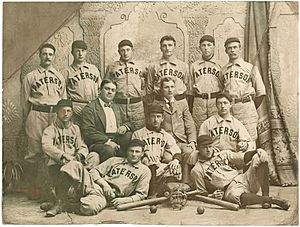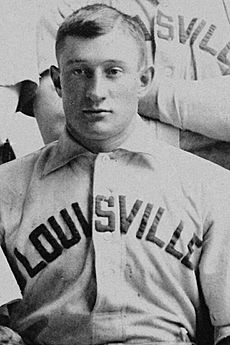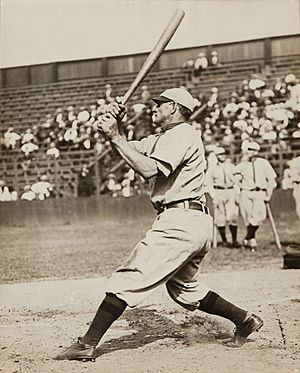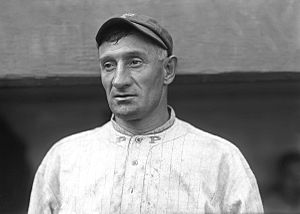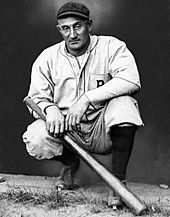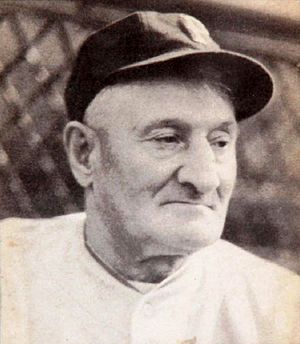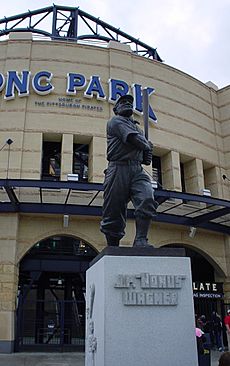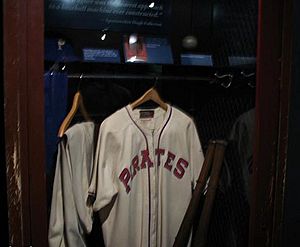Honus Wagner facts for kids
Quick facts for kids Honus Wagner |
|||
|---|---|---|---|
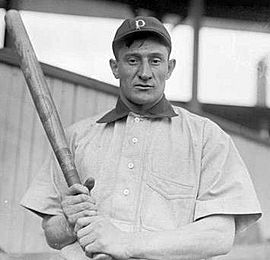
Wagner in 1903
|
|||
| Shortstop | |||
| Born: February 24, 1874 Chartiers Borough, Pennsylvania, U.S. |
|||
| Died: December 6, 1955 (aged 81) Carnegie, Pennsylvania, U.S. |
|||
|
|||
| debut | |||
| July 19, 1897, for the Louisville Colonels | |||
| Last appearance | |||
| September 17, 1917, for the Pittsburgh Pirates | |||
| MLB statistics | |||
| Batting average | .329 | ||
| Hits | 3,430 | ||
| Home runs | 101 | ||
| Runs batted in | 1,732 | ||
| Stolen bases | 722 | ||
| Teams | |||
|
|||
| Career highlights and awards | |||
|
|||
| Induction | 1936 | ||
| Vote | 95.13% (first ballot) | ||
Honus Wagner (born February 24, 1874 – died December 6, 1955) was a famous American baseball player. He played as a shortstop for 21 seasons in Major League Baseball (MLB). Most of his career was spent with the Pittsburgh Pirates.
Wagner won eight batting titles, which is a record for the National League. He also led the league in hitting for power and stealing bases many times. People called him "the Flying Dutchman" because he was very fast and had German heritage. This nickname was a fun nod to a famous story and opera.
In 1936, Honus Wagner was one of the very first players chosen for the Baseball Hall of Fame. He was inducted alongside other legends like Babe Ruth and Ty Cobb. Many baseball experts think Wagner was the best shortstop ever. Even Ty Cobb, another famous player, called him "maybe the greatest star ever". Wagner is also famous for having one of the rarest and most valuable baseball cards ever made.
Contents
Early Life and Baseball Start
Honus Wagner was born in Chartiers Borough, Pennsylvania. His parents, Peter and Katheryn, were immigrants from Germany. Honus was one of nine children. His family called him Hans, which later became Honus.
He left school at age 12 to help his father and brothers. They worked in the coal mines. In their free time, Honus and his brothers played baseball. They became so good that three of his brothers also became professional players.
Honus's older brother, Butts Wagner, helped him get his first tryout. Butts convinced his manager to watch Honus play. Before becoming a baseball star, Wagner also trained to be a barber. In 1916, Wagner married Bessie Baine Smith. They had three daughters together.
Professional Baseball Career
Before Major League Baseball
Honus's brother, Albert "Butts" Wagner, was already a known baseball player. In 1895, Albert suggested Honus for his team in the Inter-State League. That first year, Wagner played for five different teams. He played in three different leagues and appeared in 80 games.
In 1896, Ed Barrow, a manager, took Honus to his new team. This team was the Paterson Silk Sox in the Atlantic League. Barrow was good at finding talent. Wagner could play almost any position, including all three bases and the outfield. He hit very well for Paterson, with averages of .313 in 1896 and .375 in 1897.
Playing for the Louisville Colonels
Barrow knew Wagner belonged in the top league. He contacted the Louisville Colonels, an MLB team. The Colonels had a bad record in 1896. But in 1897, they were doing better.
Barrow convinced the team's president, Barney Dreyfuss, to watch Wagner play. Dreyfuss and the manager, Fred Clarke, were not very impressed at first. Wagner looked a bit awkward. He was 5 feet 11 inches tall and weighed 200 pounds. He had a big chest, strong arms, huge hands, and bowed legs.
But Dreyfuss and Clarke decided to give him a chance. Wagner played his first game for Louisville on July 19, 1897. He hit very well, with a .338 batting average in 61 games. By his second season, Wagner was already one of the best hitters in the National League.
After the 1899 season, the National League shrunk from twelve to eight teams. The Colonels were one of the teams that were removed. Their owner, Barney Dreyfuss, bought part of the Pittsburgh Pirates. He brought Wagner and many other top players with him to Pittsburgh.
Becoming a Pittsburgh Pirate Star
Moving to the Pittsburgh Pirates made Wagner a true hitting star. In 1900, he won his first batting championship. He hit .381, which was a career high. He also led the league in doubles (45), triples (22), and slugging percentage (.573). For the next nine seasons, Wagner's batting average never dropped below .330.
In 1901, another league, the American League, started signing National League players. This caused a bidding war for talented players. The Chicago White Sox offered Wagner a large contract of $20,000. But he turned it down and stayed with the Pirates.
Before 1904, Wagner played many different positions. That season, he became the full-time shortstop. He became a very skilled fielder at that position. His playing style was tough and determined. In 1898, Wagner won a contest by throwing a baseball over 403 feet.
In 1899, he became the first player to steal second base, third base, and home plate in one play. He did this again in 1902, 1907, and 1909. Wagner ended his career with the National League record for most steals of home plate (27).
In September 1905, Wagner signed a deal to create the first baseball bat with a player's signature. This was the Louisville Slugger. He was the first athlete to endorse a product. The Honus Wagner bat became a best-seller for many years.
In 1908, Wagner briefly retired. The Pirates' owner, Barney Dreyfuss, offered him $10,000 a year. This made Wagner the highest-paid Pirate for many years. He returned to the team early in the 1908 season. He had an amazing year, almost winning the Major League Baseball Triple Crown. He led the league in hitting, hits, doubles, triples, RBIs, and stolen bases.
Baseball historian Bill James calls Wagner's 1908 season one of the greatest ever. He notes that runs were much harder to score back then. This makes Wagner's hitting numbers even more impressive.
World Series Appearances
In 1903, the Pirates played in the very first World Series. They faced the Boston Americans. Wagner was a big star by then, and people expected a lot from him. However, he was not at full strength and only hit .222 in the series.
Boston fans, called the "Royal Rooters", would sing a song to tease Wagner. They sang, "Honus, Honus, why do you hit so badly?" The Pirates lost the series. Wagner was very upset about his performance. He felt ashamed and said he was "a joke" in that series.
Wagner and the Pirates got another chance in 1909. They faced Ty Cobb's Detroit Tigers. This was the only time these two great hitters played against each other in the World Series. Wagner was 35 years old, and Cobb was 22.
This time, Wagner played much better. He outhit Cobb, .333 to .231. Wagner also stole six bases, setting a new Series record. Cobb only managed two steals. The Pirates won the series in seven games.
Later Career and Retirement
In 1910, Wagner's batting average dropped to .320. This was his lowest since 1898. But he still played very well for his age. He had some of the best seasons for a shortstop over 35 years old.
Wagner won the 1911 batting title by a tiny amount. He was injured in August, which made the team slip in the standings. On June 9, 1914, at age 40, Wagner got his 3,000th hit. He was only the second player in baseball history to reach this milestone.
In July 1915, he became the oldest player to hit a grand slam. This record stood for 70 years. In 1916, Wagner became the oldest player to hit an inside-the-park home run.
In 1917, Wagner returned for his final season after another brief retirement. He was injured in July and played only a few games. He batted .265. He briefly became the team's manager, but decided it wasn't for him. He retired as the National League's all-time hit leader with 3,430 hits. It took 45 years for Stan Musial to break his hit record.
Many baseball greats, like Babe Ruth and Ty Cobb, consider Honus Wagner one of the best players ever.
Life After Playing Baseball
After retiring from playing in MLB, Wagner still loved baseball. He managed and played for a semi-pro team. He also worked for the Pirates as a coach for 39 years. He was a hitting instructor from 1933 to 1952. Future Hall of Famers like Ralph Kiner learned from him.
During his coaching years, he wore uniform number 14, then later number 33. Number 33 was later retired in his honor. Wagner was a beloved ambassador for baseball. He also coached baseball and basketball at Carnegie Institute of Technology. This school is now part of Carnegie Mellon University.
In 1928, Wagner ran for Sheriff of Allegheny County, Pennsylvania, but he lost. He was appointed as a deputy in 1942. He also ran a famous sporting goods company. A store named "Honus Wagner" was in downtown Pittsburgh for 93 years.
In 1944, the Pirates hosted the 1944 Major League Baseball All-Star Game. Wagner was invited to be an honorary coach for the National League team. This was the first time such an honor was given in the All-Star Game.
Wagner lived the rest of his life in Pittsburgh. He was known as a friendly person around town. He passed away on December 6, 1955, at age 81. He is buried in Jefferson Memorial Cemetery.
Film and Pop Culture Legacy
Wagner was one of the first athletes to appear in movies. He starred in the 1919 film Spring Fever. He has also been shown in other movies like The Winning Season (2004) and Cobb (1994).
The TV show The Simpsons mentioned Wagner in a 1992 episode. In 2000, Wagner was honored with a U.S. postage stamp. This stamp was part of a "Legends of Baseball" series.
Baseball Legacy and Honors
 |
|
| Honus Wagner's number 33 was retired by the Pittsburgh Pirates in 1956. |
When the Baseball Hall of Fame had its first election in 1936, Wagner tied for second place in votes with Babe Ruth. In 1969, on the 100th anniversary of professional baseball, Wagner was chosen as the all-time shortstop. In 1999, he was voted Number 13 on The Sporting News' list of the 100 Greatest Players. He was again the highest-ranking shortstop.
Christy Mathewson, a famous pitcher, said that Wagner was the only player he faced who had no weaknesses. Mathewson felt the only way to stop Wagner from hitting was to not pitch to him at all.
A life-size statue of Wagner swinging a bat was made by a local artist. It was placed outside Forbes Field, the Pirates' old stadium. It was dedicated on April 30, 1955, and Wagner was there to wave to his fans. The Pirates have moved stadiums twice, and the statue has moved with them. It now stands outside PNC Park, the Pirates' current home.
There is also a small stadium named after Wagner. It is behind Carnegie Elementary School in Carnegie, Pennsylvania. It is the home field for Carlynton High School sports. The Historical Society of Carnegie History Center has a Honus Wagner Sports Museum. It shows many Wagner collectibles.
The Famous T206 Baseball Card
The T206 Honus Wagner baseball card is one of the rarest and most expensive baseball cards in the world. Only about 57 copies are known to exist. The American Tobacco Company (ATC) made the card from 1909 to 1911. It was part of their T206 series.
Some people say Wagner, who didn't smoke, didn't want his picture on cigarette packs. But it's more likely that the ATC didn't want to pay him enough money. So, the ATC stopped making the Wagner card. Only a small number of cards were given out to the public. For other players, tens or hundreds of thousands of cards were made.
In 1933, this card was first listed at $50 in a baseball card catalog. This made it the most expensive baseball card at that time. The front of the T206 cards had a colorful picture of the player. The back of the cards showed the names of cigarette brands like Piedmont and Sweet Caporal.
The ATC asked baseball players for permission to use their pictures. Wagner was a top player and was considered the best at the time. He had appeared in ads for other products. So, the ATC asked him for his picture. According to a newspaper from 1912, Wagner did not agree. He said he "did not care to have his picture in a package of cigarettes". He even threatened to take legal action if they used his picture.
A T206 Wagner card in good condition sold for $2.8 million in 2007. This was the highest price ever for a baseball card at the time. In 2010, a card was donated to a group of nuns. Even though it was in poor condition, it sold for $262,000.
The value of these cards has continued to grow. In 2016, a T206 Wagner card sold for $3.12 million. In May 2021, one sold for $3.75 million. In August 2021, another sold for $6.6 million. On August 3, 2022, a T206 Honus Wagner card sold for a record $7.25 million.
The card was also featured in the plot of the Nickelodeon film Swindle.
Career Statistics
Here are Honus Wagner's official career statistics from MLB.com:
| G | AB | R | H | 2B | 3B | HR | RBI | SB | CS | BB | SO | AVG | OBP | SLG | OPS+ | TB |
|---|---|---|---|---|---|---|---|---|---|---|---|---|---|---|---|---|
| 2,792 | 10,430 | 1,736 | 3,430 | 640 | 252 | 101 | 1,732 | 722 | 15 | 963 | 327 | .329 | .392 | .466 | N/A | 4,862 |
Images for kids
See also
 In Spanish: Honus Wagner para niños
In Spanish: Honus Wagner para niños
- 3,000 hit club
- List of Major League Baseball career doubles leaders
- List of Major League Baseball career triples leaders
- List of Major League Baseball career runs scored leaders
- List of Major League Baseball career runs batted in leaders
- List of Major League Baseball players to hit for the cycle
- List of Major League Baseball annual runs batted in leaders
- List of Major League Baseball batting champions
- List of Major League Baseball career stolen bases leaders
- List of Major League Baseball annual runs scored leaders
- List of Major League Baseball annual stolen base leaders
- List of Major League Baseball annual doubles leaders
- List of Major League Baseball annual triples leaders
- List of Major League Baseball player-managers
- Major League Baseball titles leaders


